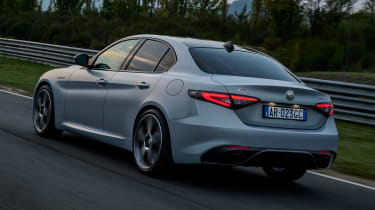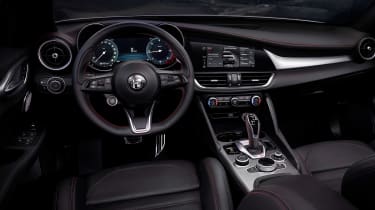New Alfa Romeo Giulia facelift: updated tech and revised line-up for 2023
Alfa Romeo’s BMW 3 Series rival will receive a fresh look and new tech for 2023 as well as a rejigged engine and trim line-up
The Alfa Romeo Giulia has been given a new look and improved technology for the 2023 model year. The saloon car was launched in 2016 and treated to some smaller tweaks in 2020, but the latest changes go a little further.
The updated Giulia is launching alongside the brand’s refreshed Stelvio SUV, and both cars will be offered to customers from the beginning of 2023. A revised line-up now consists of Sprint and Veloce trim levels, plus a new Competizione range-topper, mirroring the trim structure for the newer Tonale SUV.
Taking further inspiration from that vehicle, the Giulia adopts a subtle redesign featuring a 3x3 headlight signature (a design touch which can be traced back to the SZ Zagato) with adaptive LED Matrix technology, plus a new ‘Trilobo’ grille to provide what Alfa Romeo refers to as a “strong family resemblance with the Tonale”. The clusters also feature adaptive lighting technology which adjusts the dipped beam according to the speed of the car and driving conditions, Meanwhile, the rear light clusters are also new, and use smoked glass.
The biggest change comes inside in the shape of the all-new 12.3-inch digital dash panel. It can be switched between three different layouts: Evolved, Relax and Heritage, each placing more or less emphasis on particular driving instruments. In Evolved mode the speedometer and rev counter sit either side of a central information readout. Relax reduces the level of information on display for a less cluttered look, while Heritage offers a more retro design.
One of the Giulia’s strongest attributes has been the way it drives and Alfa Romeo hasn’t messed with the formula with this update. The eight-speed automatic gearbox is retained with column-mounted aluminium shift paddles, sending power to the rear wheels. Alfa Romeo’s Q2 mechanical limited-slip differential will also be available.
To begin with, the refreshed Giulia will only be available with one engine available - the same 276bhp 2.0-litre four-cylinder turbocharged petrol engine that powers the outgoing car; the 197bhp version of the same unit has been removed from the range in the name of simplification, while the 2.2-litre diesel engine has not been brought back with this update. We expect the hot 503bhp 2.9-litre twin-turbo V6 Giulia Quadrifoglio super saloon will receive the exterior and interior updates at some point during the fast half of 2023.
Sprint and Veloce trim levels are similar to the current range structure, but when the new car goes on sale early next year the Competizione version will mark a new addition to the range. It features an exclusive matte grey paint finish as per its Stelvio sibling, red brake calipers and adaptive active suspension that can be changed depending on drive mode.
The new Giulia is still based on the same Giorgio platform, and features double wishbone suspension at the front and a mutli-link set-up at the rear, with plenty of lightweight aluminium components to help keep the car’s kerbweight down and retain its trademark agility as the closest rival in handling terms to the newly updated BMW 3 Series.
Inside, along with the new digital dash Competizione models receive a Harman Kardon sound system, a leather-upholstered dashboard and sporty seats with red stitching.
The Non-Fungible-Token (NFT) technology which premiered on the Tonale has also made its way over to the Giulia. Dubbed a “world exclusive in the automotive field,” Alfa Romeo has now rolled the concept out to its entire range. It involves “an encrypted and non-modifiable digital register” which contains various data such as servicing information.
Pricing will be confirmed early next year, and we’re expecting a small increase over the outgoing 276bhp car’s £46,199 price tag.
Click here for our list of the best executive cars on sale right now...











